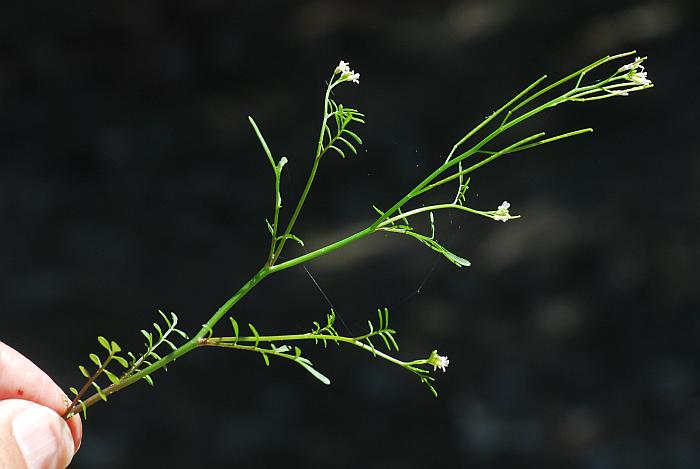Cardamine parviflora L.
Small-Flowered Bitter Cress

Native
CC = 3
CW = 3
MOC = 74
© SRTurner
Cardamine parviflora L.Small-Flowered Bitter Cress | |
 |
Native CC = 3 CW = 3 MOC = 74 |
© SRTurner |
|
Family - Brassicaceae Habit - Annual forb with fibrous roots. Stems - Ascending to erect, to 30 cm, glabrous.
Leaves - Basal and alternate, compound, glabrous. Basal leaves few at flowering time, 4-10 cm long, short-petiolate, pinnately compound with 5-13 leaflets 0.3-3.0 mm wide, the lateral leaflets linear to narrowly wedge-shaped or oblanceolate, entire or with 1-2 irregular teeth, tapered to a sessile or short-stalked base, this not expanded along the rachis, the terminal leaflet about as wide as or somewhat wider than the lateral leaflets. Stem leaves usually 5-8, 2-6 cm long, pinnately compound with 5-13 leaflets, these linear to oblanceolate or narrowly wedge-shaped, tapered to the base and not expanded along the rachis, the terminal leaflet about as wide as or slightly wider than the lateral ones.
Inflorescences - Racemes at branch tips, the flowers not subtended by bracts.
Flowers - Sepals 4, 1.0-1.5 mm long, green. Petals 4, 1.3-3.0 mm long, white. Stamens usually 6. Styles 0.3-0.7 mm long.
Fruits - Siliques 10-20 mm long, 0.6-0.9 mm wide, ascending but not appressed to inflorescence axis. Seeds 0.6-0.9 mm long, oblong in outline, the surface with a netlike or honeycomb-like pattern of ridges and pits, orange.
Flowering - March - July. Habitat - Forest openings, ridges, slopes, glades, ledges, disturbed areas, typically on rocky or acidic substrate. Origin - Native to the U.S. Lookalikes - Planodes virginicum, also other species of Cardamine, particularly C. pensylvanica. Other info. - This little species is sometimes ignored due to its somewhat weedy appearance; however, its habitat preference is actually somewhat conservative. It is found throughout Missouri and the eastern half of the continental U.S. Of the small white-flowered mustards, this one is typically the smallest in stature and most delicate in appearance. However, these attributes are quite variable and the plant can sometimes be easily mistaken for its lookalikes. The very common C. hirsuta is usually easily recognized by its more lushly developed basal leaves and flowers with four instead of six stamens, whereas Planodes virginicum has a more well-developed basal rosette and fruits which are distinctly flattened when mature. Differentiation from C. pensylvanica can be difficult, but that species is typically more robust, with wider leaflets. Photographs taken at Danville Conservation Area, Montgomery County, MO, 4-20-2019, and at Don Robinson State Park, Jefferson County, MO, 4-26-2019 (SRTurner). |